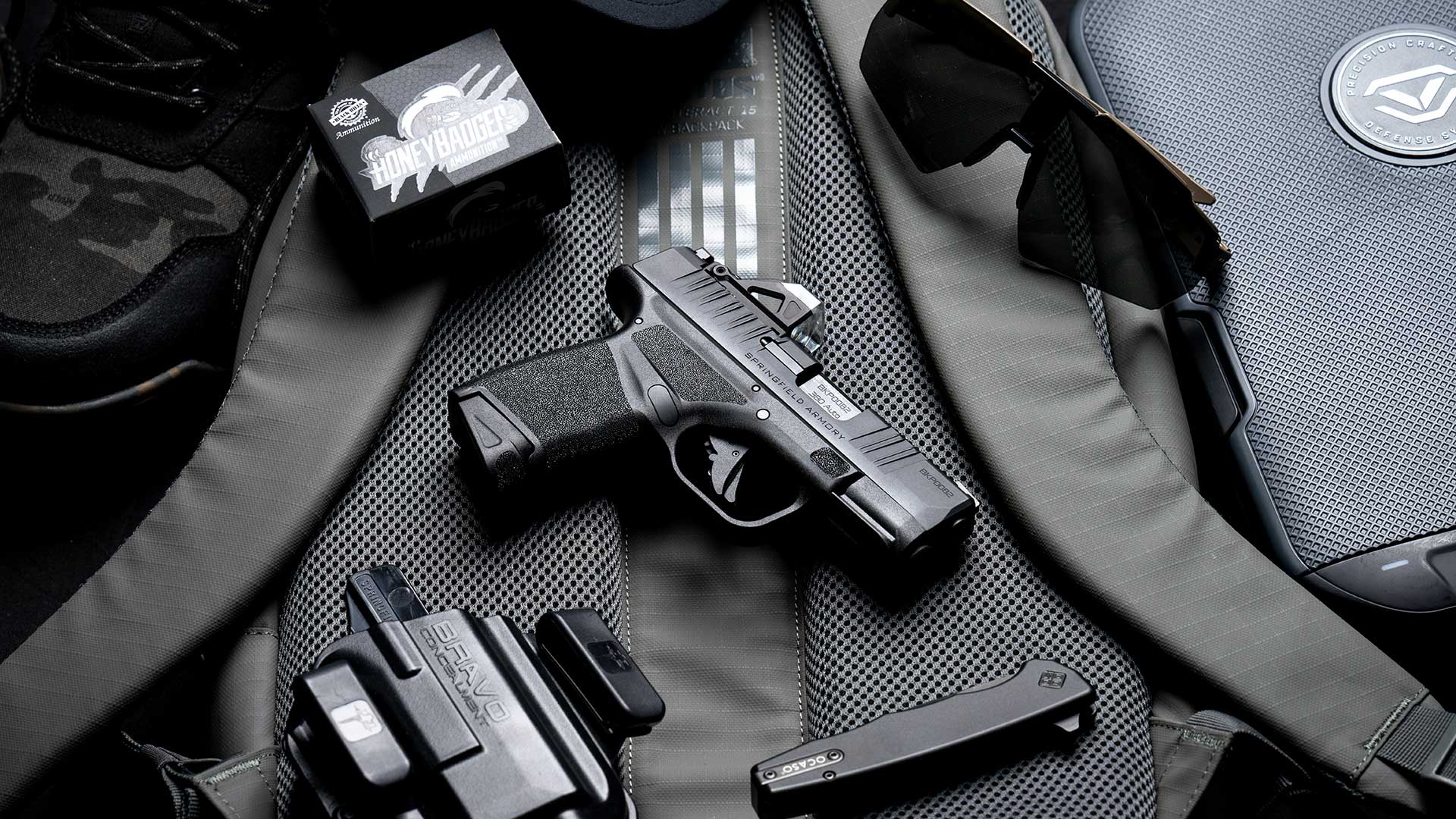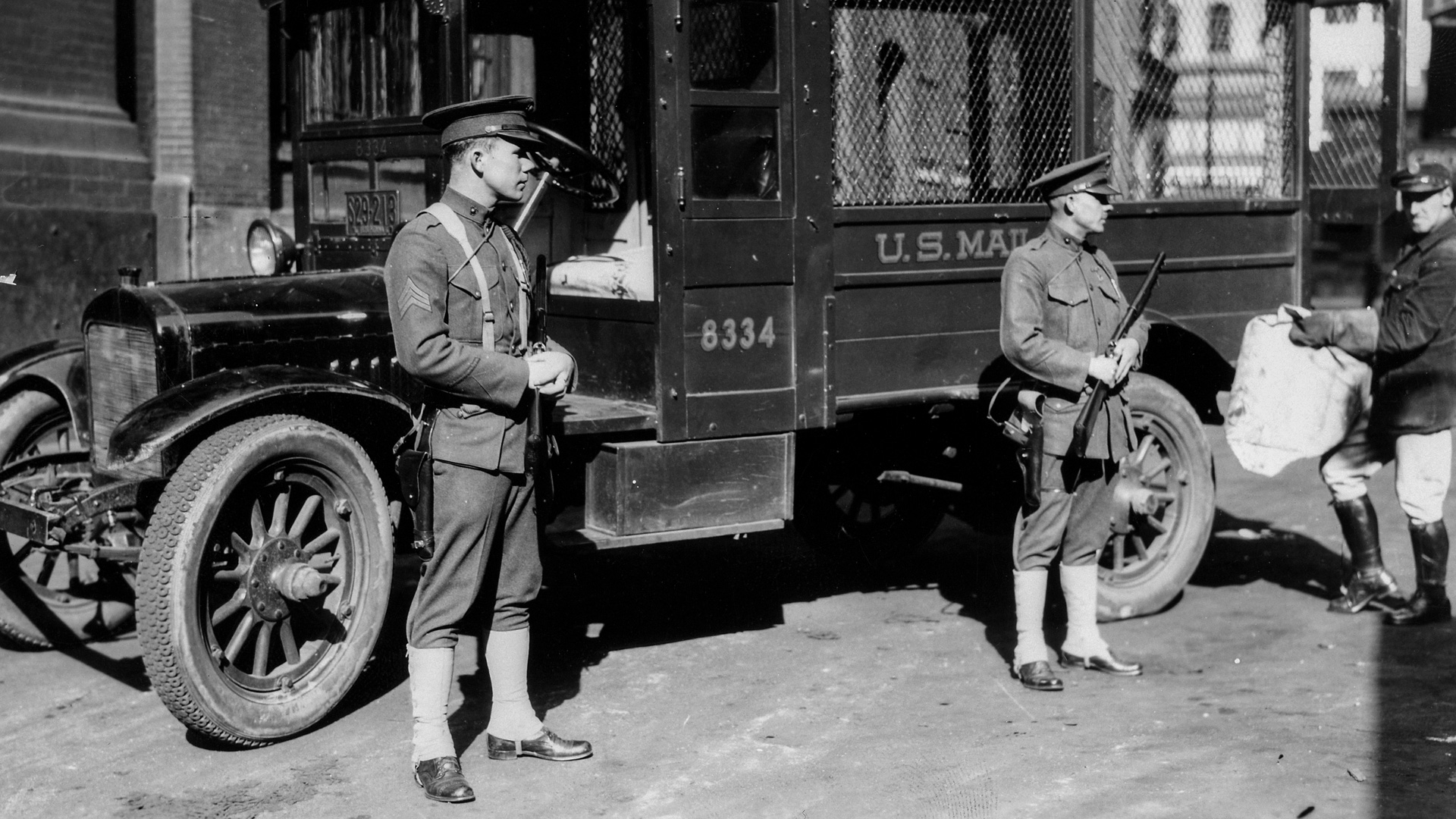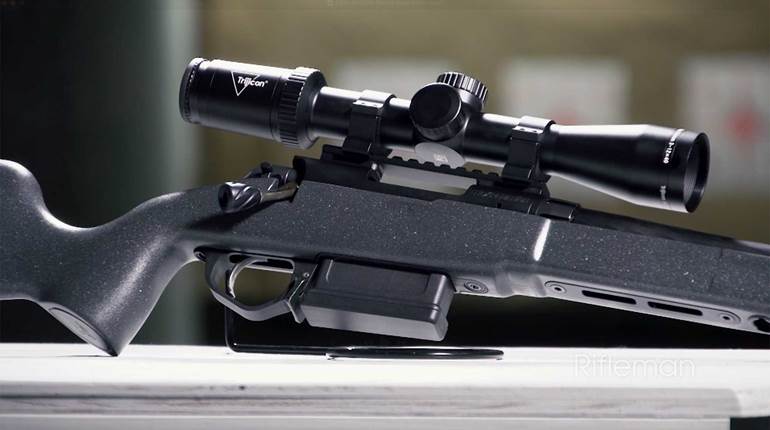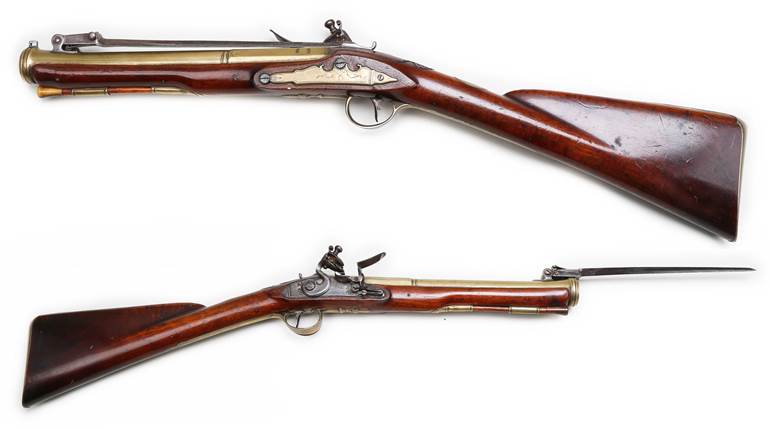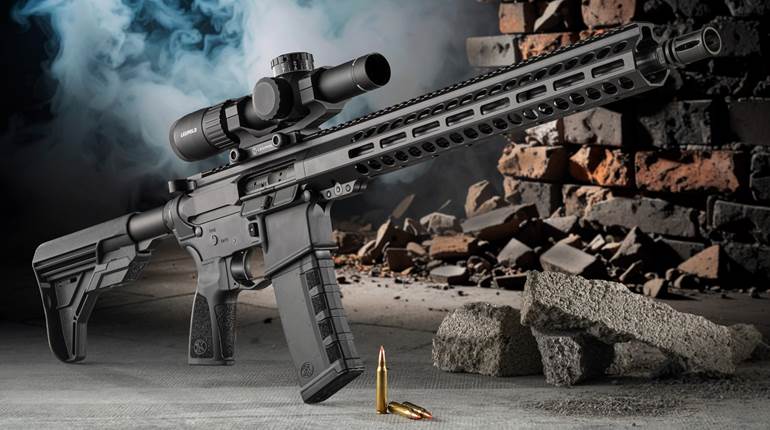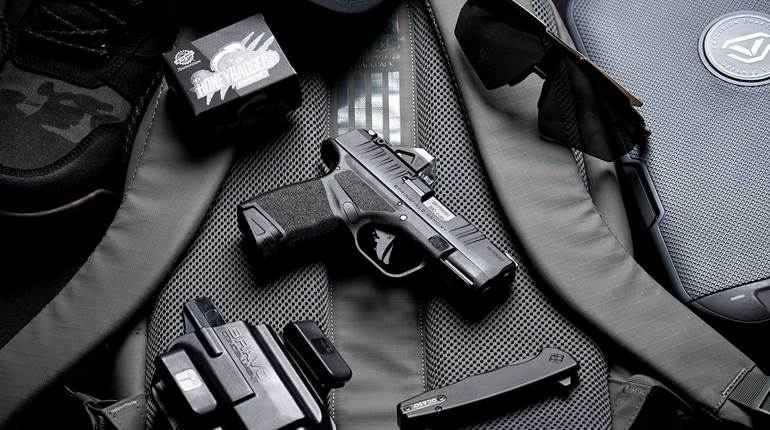
In 1855, the U.S. Army adopted the Maynard tape primer system and the .58-cal., hollow-base Minié ball as standard features on its new small arms, including the muzzleloading .58-cal. Model 1855 Pistol Carbine. While produced only in small quantities, the M1855 nonetheless remained in limited service for nearly a decade.
 Chief of Ordnance Col. Henry K. Craig reported to Secretary of War Jefferson Davis on June 26, 1855, on the ordnance board recommendations regarding the establishment of new arms for military service. In reference to the carbine, Craig stated, “.58 inch is proposed for all small arms … 10 inch for the barrel of the pistol, which barrel, being also provided with a suitable stock, will answer for a dragoon or artillery carbine, for which a range of 500 yards fits it … a small lock, with magazine for 25 primers, will serve for either the pistol or artillery carbine … .”
Chief of Ordnance Col. Henry K. Craig reported to Secretary of War Jefferson Davis on June 26, 1855, on the ordnance board recommendations regarding the establishment of new arms for military service. In reference to the carbine, Craig stated, “.58 inch is proposed for all small arms … 10 inch for the barrel of the pistol, which barrel, being also provided with a suitable stock, will answer for a dragoon or artillery carbine, for which a range of 500 yards fits it … a small lock, with magazine for 25 primers, will serve for either the pistol or artillery carbine … .”
Davis approved the recommendations on July 5, 1855, and wrote: “the pistol will be provided with a movable stock, by the application of which, it may be used as a carbine by light artillery and mounted troops.” Further testing concluded that accuracy, as well as the energy generated, increased with the length of the barrel. On Aug. 23, 1855, the recommendation was made to increase the length of the barrel from 10" to 12".
The .58-cal. M1855 Pistol Carbine’s overall length with its attachable shoulder stock was 281/4", and it weighed 5 lbs., 7 ozs. The pistol alone was 173/4"-long and weighed 3 lbs., 13 ozs. The shoulder stock and the pistol’s stock were both oil-finished, black walnut. The lock was fitted with a Maynard tape primer magazine holding 25 pellet primers in its tape. The primer door was stamped with a large spread eagle, and forward of the door is stamped “U.S./SPRINGFIELD” on two lines. To the rear of the C-shaped hammer was the date, either 1855 or 1856. The bright 12" barrel had an iron blade front sight and a two-leaf rear sight graduated to 400 yds. The nipple bolster was equipped with a clean-out screw. The upper left flat was stamped with the proofmarks “V/P” and an eagle head, and the date was marked on the top barrel flat near the breech. The barrel was held by a single flat brass band with a sling swivel mounted on it. The barrel band was retained by a conventional spring forward of it. The ramrod swivel lug was brazed to the bottom of the barrel, while the button-head ramrod was held in place by a double-arm swivel. A lanyard ring was mounted on the buttcap, while the toe of the attachable stock was equipped with a sling swivel. Batch numbers from 1 through 25 are found on the backstrap of the pistol and the brass yoke of the shoulder stock. The tang of the buttplate is stamped “U.S.”
Maynard’s tape primer system was patented in September 1845 by Dr. Edward Maynard, a Baltimore dentist. Its purpose was to eliminate the need to manually place a percussion cap on the nipple each time the pistol was fired. A paper roll carrying the priming compound was advanced over the nipple each time the hammer was cocked; the system is similar to what is used by many toy “cap” guns. However, the pistol could still be fired with conventional percussion caps. The cartridge finally settled on for the M1855 Pistol Carbine had a .577"-diameter Minié-style elongated ball with a bullet weight of 450 grs., a blackpowder charge of 40 grs. and an overall length of 1.9".
Production on the M1855 began in the fall of 1855. By the end of June 1856, Harpers Ferry Armory had fabricated three pistol carbines and Springfield Armory had manufactured 1,003 pistol carbines. Between late 1855 and June 30, 1857, 4,019 M1855 Pistol Carbines were manufactured at Springfield Armory, plus the three at Harpers Ferry.

Pre-War Field Service
In 1855, Congress authorized the formation of the 1st and 2nd U.S. Cavalry, and the two regiments were formed at Jefferson Barracks, Mo., during the spring and summer of 1855. In July, several officers from the two regiments were appointed to a Cavalry Equipment Board convened in Washington, D.C. The board’s recommendations were published in General Order Number 13 on Aug. 15, 1855, which called for one squadron—two companies—of each regiment to receive the M1855 Pistol Carbines. Since the guns were not in production, the companies were issued other arms. The first 1,000 pistol carbines were sent from Springfield Armory to Maj. George Ramsey at St. Louis Arsenal in June 1856. By the spring of 1857, one squadron of the 1st Cavalry was issued M1855 pistol carbines. Second Lieutenant Eli Long’s Company “H,” 1st Cavalry, was issued M1855 pistol carbines, Greene carbines, Colt and Adams revolvers plus M1840 dragoon sabers. Captain Eugene Carr’s Company “I” was similarly armed. The balance of the regiment was issued musketoons and rifled carbines.

The 1st U.S. Cavalry, commanded by Col. Edward V. Summers, left Fort Leavenworth to take to the field against the Cheyenne in May 1857. The expedition’s goal was to punish the Cheyenne for their raids against emergent wagon trains during which 12 individuals had been killed and two kidnapped. Long and Eli companies were part of the expedition. On July 29, 1857, on the banks of the Solomon River, the two sides came upon one another. Being a mile apart, the sides charged each other. Colonel Summers gave the command to “gallop march.” Then, to the surprise of his men, the colonel commanded “sling carbines, draw sabers, charge.” The saber charge caught the Cheyenne by surprise, and they quickly retreated. During the seven-mile fighting retreat, nine Cheyenne were killed and an unknown number were wounded. The soldier casualties were two killed and nine wounded, and one of the wounded was Lt. Jeb Stuart. The saber charge was the first one made in the West. The following year, eight companies were re-armed with Sharps carbines, and Long’s and Carr’s companies were issued First Model Burnside carbines.
Several companies of the 1st Dragoons assigned to the New Mexico Territory in 1857 were issued M1855 Pistol Carbines. In May 1857, Capt. Richard Ewell’s Company G, 1st Dragoons, received 45 of the guns. The afternoon of June 27, Ewell’s men were part of a force that attacked the Coyotero Apache village on the Gila River. The attack left 40 warriors killed and wounded, and 45 women and children captured. The soldier casualties were two killed and seven wounded. Four months later on Sept. 23, Ewell reported that 18 of his 45 pistol carbines were unserviceable; eight stocks and 10 hammers were broken. “Without the stock, they are an ordinary dragoon pistol. The attachment is not firm and therefore the arm is unsteady.” Captain Ewell concluded his report noting “so that in arming 45 men for 4 [months], 18 are unserviceable. For these reasons, I [think] that the weapon is not suitable for dragoon use.” Captain Ewell exchanged his pistol carbines in 1858 for the M1853 Sharps carbines. By this time most, if not all, of the 1,538 M1855 Pistol Carbines issued to the cavalry and dragoon regiments were then in storage.

All the .58-cal. U.S. Model 1855s, including the rifle-musket (l.), could hold 25 Maynard tape primers in their locks or be fired with standard percussion caps. A folding leaf rear sight on the pistol carbine was graduated to an optimistic 400 yds. (ctr.). Beneath the barrel, a button-head ramrod was retained by a double-arm swivel (r.).
Civil War Field Service
Due to insufficient quantities of carbines for cavalry use in the early stages of the war, Army policy was to issue only 10 carbines per company. In early 1862, the 9th Illinois Cavalry received Hall and M1855 Pistol Carbines, totalling about 120 carbines, plus revolvers and sabers.
The summer of 1862 found the 9th Illinois assigned to duty in Arkansas. One day while in the process of obtaining corn for the Army quartermaster at a local plantation, they were informed of Southern forces nearby. The Confederates were strongly posted among trees on the edge of a swamp. The Ninth charged the Confederate position several times without success. In the half-hour engagement, the Ninth suffered casualties of one killed and 31 wounded. The Confederates casualties were not stated.
 As one of only three handgun models made at Springfield Armory—the other two being the U.S. Model 1817 flintlock and the M1911—and due to their limited production numbers, the U.S. Model 1855 is popular with collectors. Be cautious, however, as modern-made shoulder stocks have been observed.
As one of only three handgun models made at Springfield Armory—the other two being the U.S. Model 1817 flintlock and the M1911—and due to their limited production numbers, the U.S. Model 1855 is popular with collectors. Be cautious, however, as modern-made shoulder stocks have been observed.
A combined force of infantry and cavalry departed Helena, Ark., in November 1862 on a diversion raid on the railroad near Grenada, Miss. The force included 300 men of the 1st Indiana Cavalry. The cavalrymen were partially armed with M1855 Pistol Carbines. On the second night out, they came upon a Confederate camp on the other side of the banks of the Coldwater River. The camp was totally unaware of the approaching Union force on the opposite banks of the river; the Confederates were around their campfires, laughing, talking and singing. The 1st Indiana quietly placed their four howitzers in position to fire, dismounted the remaining men and took up positions on the riverbank. When the command was given to fire, the howitzers and dismounted men opened fire into the camp. The Confederates fled in all directions, with three killed and five wounded. Later in the expedition, the cavalrymen were proceeding down a narrow road and found the road blocked by the 1st Texas Legion Cavalry. Both sides fired a volley, and the Confederates charged, causing the Indiana cavalrymen to retreat. Both sides suffered about eight casualties. The 1st Indiana Cavalry was still listing 72 pistol carbines as late as the fall of 1863. They were also reporting 101 Hall and 10 Sharps carbines.

Back east in the fall of 1862, the 2nd West Virginia Cavalry was armed with both M1855 Pistol Carbines and Smith carbines. The regiment was engaged in scouting, operating against bushwhackers and Confederate forces. In a blinding snowstorm on Nov. 26, 1862, the 2nd attacked a Confederate camp in the area of Greenbrier County, W.Va. More than 115 Confederates soldiers were killed, wounded or captured. Nearly 200 Enfield and Mississippi rifles, plus 50 sabers, were destroyed. The 2nd’s only losses were two horses. On the trip back to camp, several men suffered severe frostbite. At the end of December 1862, the regiment was listing in inventory 66 M1855 Pistol Carbines and 165 Smith carbines.
The cavalry inventory returns for Dec. 31, 1862, reflected nine cavalry regiments reporting more than 600 M1855 Pistol Carbines in inventory. The cavalry regiments included: 9th Illinois, 1st Indiana, 2nd, 5th and 6th Kansas, 4th Missouri, 2nd Ohio, and the 1st and 2nd West Virginia. The largest quantity of pistol carbines, 260, was issued to the 1st Indiana.
As of the end of 1862, the Federal arsenals and ordnance depots were listing 1,411 M1855 Pistol Carbines in storage. The largest quantities were at the Wheeling W.Va., depot with 590, at Fort Union, N.M., with 303, and at Washington Arsenal with 283. A year later on Jan. 2, 1864, the quantity of M1855 Pistol Carbines in storage was listed as 559.

Interestingly, the M1855 was used against the Union cavalry in the Colorado Territory not by Confederates forces but by the Cheyenne. In April 1864, 40 cavalrymen from the 1st Colorado Cavalry were sent out to try to recover livestock taken from the local ranchers by the Cheyenne during recent raids. The soldiers were armed with Whitney revolvers and sabers, but no carbines. Splitting into two parties, one group with one officer and 15 men overtook the Cheyenne. A few Cheyenne came forward to shake the soldiers’ hands; when the officer demanded the return of the livestock and started to try to disarm them, the Cheyenne fired at the soldiers and rode off. During the running fight that followed, several Cheyenne were killed. The pursuit was called off after 15 miles due to the horses giving out. Arrows, a lance and an M1855 manufactured at Springfield Armory in 1855 were recovered from the Cheyenne.
The Marine Corps Museum has an M1855 Pistol Carbine on display that was carried by Lt. Robert W. Huntington during the war. Huntington was commissioned a second lieutenant in June 1861. He was part of the Marine battalion that took part in the July 21, 1861, Battle of Bull Run. During the war, Huntington had served aboard the U.S.S. Jamestown.
The M1855 Pistol Carbine remained in service in limited quantities throughout the war. As late as May 1865, the Department of Missouri was listing 136 of the carbines in field service. The M1855 Pistol Carbine was the last of only two single-shot handguns manufactured at Springfield Armory.






















